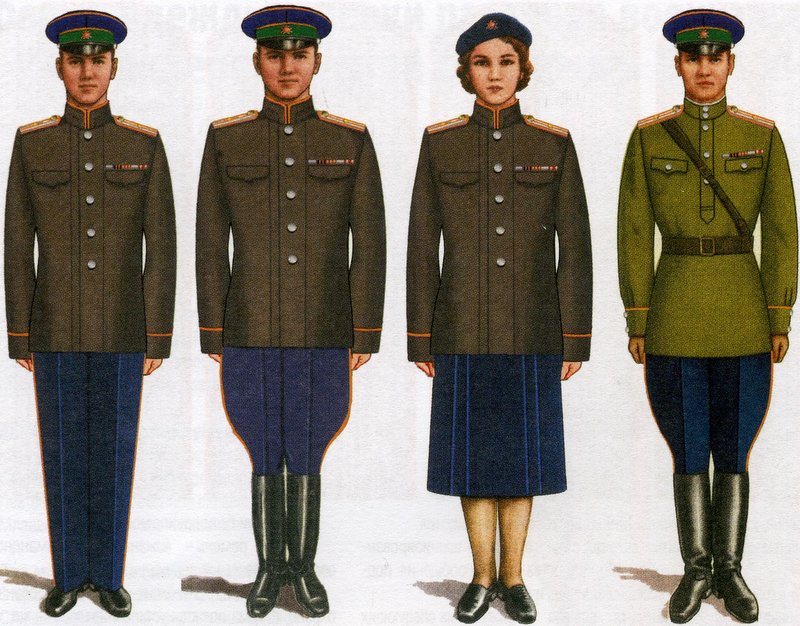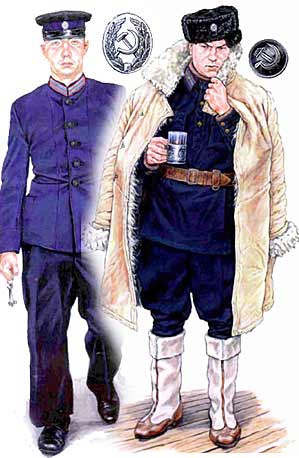 Caps of Militarized Guards (VOKhR)
Caps of Militarized Guards (VOKhR)The abbreviation VOKhR (in Cyrillic: ВОХР (ВОЕНИЗИРОВАННАЯ ОХРАНА)) was first used from 1917 to refer to troops of State Security or VeCheka (the predecessors of the KGB). However, in post-war usage it referred to uniformed civilian security guards - the caps of which I will describe on this page. There were two general categories of VOKhR: departmental (ministry) paramilitary security forces and guards at individual economic or industrial entities. Departmental security forces in particular were organized along military-style lines and were authorized to carry rifles and pistols while on duty (even being referred to as "Riflemen," at least in the Railways Ministry). While civilian (often former military), these organizations were closely regulated by the Ministry of Interior.
Virtually every government ministry (including the Ministry of Defense) had its own VOKhR force at one time or another and there was no real attempt to standardize uniforms among ministries prior to 1961. Consequently, most VOKhR wore caps of their supported ministries - sometimes with special VOKhR cockades but not always. In 1961, by resolution passed by the USSR Council of Ministers, all departmental VOKhR - with the exception of Railways, Civil Aviation, and MORFLOT/River Fleet - were to adopt a dark blue uniform with insignia of rank on collar tabs. Subsequent decrees specified green banding on corresponding uniform caps. Non-departmental VOKhR apparently standardized on this uniform by 1965 (although ex-Soviet Army khaki field uniforms were also commonly worn with green tabs and VOKhR rank insignia). And, although Railways and Civil Aviation were initially exempt from this standardization, they too eventually adopted dark blue uniforms with green facings for their armed security forces (as did the Ministry of Defense in 1967). It appears VOKhR at civilian marine agencies always wore caps of those agencies. Cap cockades were also largely standardized, even though Railways and Civil Aviation personnel usually added their own ministry "wings" to the crown of their caps or even dispensed entirely with the VOKhR cockades in favor of their ministry's. As you will see below, the Forestry Ministry carried this one step further by creating its own unique VOKhR cockade design.
As you will see from my descriptions below, there were a number of color and sewing variations in post-1961 VOKhR caps - despite the intent to standardize them after that date. Most collectors believe this variation came from rather incomplete descriptions in relevant uniform regulations as well as the common use of black or nearly black fabrics to satisfy the "dark blue" color requirement - especially in older caps. Consequently, you will see crown colors in black and blue, and piping colors range from green to dark blue to black to none at all! Sometimes these variations occurred even at the same garment factory in the same year! Availability of appropriate cloth undoubtedly also played a factor in this variation - since VOKhR caps were not subject to the same quality control as those destined for the Soviet Army or Navy.
VOKhR Railways
Rifleman
1949-1960
The caps shown here were worn with the M1949 uniforms illustrated above; junior command staff/rank and file to the left and middle/senior command staff to the right (missing cockade). These caps from Russian collections have the regulation dark blue crowns with green bands (velvet for senior officers; wool for all others) and orange piping. Orange piping is a true rarity in Soviet usage; it was only otherwise used on some cavalry caps in the 1920s.
A unique star and crossed rifles cockade was authorized for this cap, shown pinned to the cap on the left. Black oilcloth chinstraps were prescribed for all ranks and were
held in was held in place by silver buttons embossed with the same shape as the cockade. A fiberboard visor completed the cap's design elements. The exact phase-out date for this cap has
not been published; I've seen one marked 1959 but expect it remained in service through at least 1960.
Very Rare
VOKhR
Junior Command Staff/Rank and File
1961-1968
This is an example of caps standardized by VOKhR uniform regulations in 1961 and 1965. As prescribed by those regulations, the crown is "dark" blue and the band is green. Middle and senior grade staff were authorized
wool crowns while more junior personnel were to make due with cotton fabric - as shown here. The band is flannel material - rather than the later wool fabric used on all caps.
There is no piping, reflecting 1961/1965 regulations which made no reference to them. The visor is black painted fiberboard and the chinstrap is black oilcloth. All VOKhR personnel, no matter the grade, wore
chinstraps during this period. This chinstrap is secured with two silver buttons embossed with a circular target with crossed rifles design. Finally, a cockade of the 1961 model is pinned through the band.
It consists of a heavy silver metal dome with a separately produced and pinned red enamel star with gilt crossed rifles extending from the sides.
Rare
VOKhR
Junior Command Staff/Rank and File
1969-1977
This 1972-dated cap represents the next evolution in VOKhR caps. The crown is very dark blue (black in reality) colored wool blend while the band is green wool.
As with the cap above, there is no piping - although by this time some caps were also manufactured with dark blue piping (see the box below). The visor is black painted fiberboard and black chinstraps remained
standard for all grades. However, by this time the silver "target and crossed rifle" buttons had been phased out; replaced by standard gilt Soviet Army buttons with embossed star/hammer and sickle.
NOTE: while the 1969 regulations made reference to silver buttons; based on my observations gilt buttons rapidly replaced them in actual usage. The other defining
aspect of this cap is the M-1969 VOKhR cockade consisting of a gilt aluminum dome with a separately attached red lacquered star and crossed rifles emblem.
Available
VOKhR
Junior Command Staff/Rank and File
1978-1991
From the late 1970s and through the 1980s, VOKhR caps were produced in both dark blue and "near-black" colors with either blue-black piping, green piping, or no piping at all. The reasons for this wide variance remains illusive - although vague regulations concerning piping and differing definitions of "dark blue" are the most likely. Not until 1986 was piping (green) specifically mentioned in regulations - and even then seemed to have been ignored as needed by hat manufacturers. Even black piping on blue crowns were produced, although it appears that color combination was Russian, produced after 1991. The 1970s and 80s also saw a bewildering mixture of crown sizes and visor types used in VOKhR caps - with earlier versions of both extending in production long after they were phased out in caps produced for the military.
The 1990-dated cap shown here is typical of the last VOKhR caps produced under the Soviet regime. The crown is larger - both in circumference and in height - than caps produced
in the 1960s and 70s. It is also a true dark blue - not the "near-black" common in older caps. Some black caps did continue in production until at least 1989 (see below), but blue replaced it on most production lines in the 1980s.
Piping is green wool, as is the band. Pinned to the band is the one-piece gilt aluminum M-1978 VOKhR cockade. The visor is the later large one-rim plastic model. Black plastic chinstrap and gilt Army buttons complete the design.
Common
VOKhR Railways
Junior Command Staff/Rank and File
1973-1978
This cap, dated 1978, combines a VOKhR cap with the gilt aluminum cockade and winged emblem in use by Railways personnel during the period 1973-1978.
Wearing their own ministry's insignia on standard VOKhR caps was commonly done by personnel of both Railways and Civil Aviation.
Other than the Railways emblems, the cap is pretty standard for the late 1970s. It has a true dark blue crown with green piping and banding, combined with a small plastic visor, plastic chinstrap and Army-style gilt buttons.
Scarce
VOKhR
Middle/Senior Command Staff
1978-1991
This cap is an example of older style design elements being used in late period cap production. Dated 1986, this cap still has the smaller near-black
crown and small black fiberboard visor normally seen in the 1970s. It has the normal green band and dark blue piping. What marks this as a cap
belonging to middle or senior command staff are the gold filigree cords (instead of the black chinstrap) and the commander's version of the
M-1978 cockade - in which the cockade is pinned through a separate aluminum wreath and then to the band.
Scarce (with this insignia)
Estonian VOKhR
Junior Command Staff/Rank and File
1961-1968
VOKhR and militarized fire protection forces were closely aligned - sharing facilities and overall responsibility for the protection of physical assets of the
supported organization. Consequently, it could be expected that we would see some overlap of uniform elements. This cap - overall black wool with red piping - was normally associated
with volunteer fire companies of Estonia and Latvia in the 1960s. See my page on Fire Defense for more information. However,
this 1966-dated cap was apparently worn by a VOKhR member - displaying the M-1961 silver domed cockade of that service on the band. Unfortunately,
there is no further information available as to whether the owner was also a member of fire defense or if other Estonian VOKhR departments
just worn the same cap. The other features of the cap are normal for those dating from the 1960s: small fiberboard visor, black oilcloth chinstrap and Soviet Army buttons.
Rare


